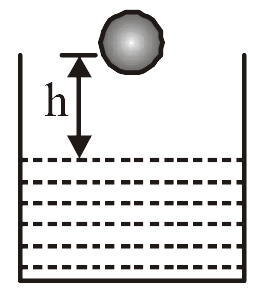A ball of radius r and density r falls freely under gravity through a distance h before entering water. Velocity of ball does not change even on entering water. If viscosity of water is η the value of h is given by

29r2(1−ρη)g
281r2(ρ−1η)g
281r4(ρ−1η)g
29r4(ρ−1η)g
Step by step video & image solution for A ball of radius r and density r falls freely under gravity through a distance h before entering water. Velocity of ball does not change even on entering water. If viscosity of water is eta the value of h is given by by Physics experts to help you in doubts & scoring excellent marks in Class 11 exams.
Topper's Solved these Questions
Similar Questions
A spherical ball of radius 3×10−4m and density 104kg/m3 falls freely under gravity through a distance h before entering a tank of water. If after entering the water the velocity of the ball does not change, find h the viscosity of water is 9.8×10−6N−s/m2
View SolutionA small ball of radius 'r' falls freely under gravity through a distance 'h' before entering a tank of water. If after entering the water, the velocity of ball does not change, the 'h' is proportional to
View Solution
Knowledge Check
- Question 1 - Select One
A metal ball ofradius 10−4 m and density 104kg/m3 falls freely under gravity through a distance 'h' and enters a tank of water. It is found that after entering the water, the velocity of ball does not change. What is the value of h?
[ηfor water 10−5 Pas ,g=10m/s2 and orhwater=103kg/m3]A10mB15mC18mD20m - Question 2 - Select One
A solid ball of density half that of water falls freely under gravity from a height of 19.6 m and then enters water. Neglecting air resistance and viscosity effect in water, the depth up to which the ball will go is (g=9.8m/s2)
A19.6 mB9.8 mC14.7 mD12.7 m - Question 3 - Select One
A small steel ball of mass m and radius r is falling under gravity through a viscous liquid of coefficient of viscosity η. If g is the value of acceleration due to gravity. Then the terminal velocity of the ball is proportional to (ignore buoyancy)
Amg(η)rBmg(η)rCmgrηDmgrη
A small ball of radius 'r' falls freely under gravity through a distance 'h' before entering a tank of water. If after entering the water, the velocity of ball does not change, the 'h' is proportional to
View SolutionA spherical ball of radius 3.0×10−4m and density 104kg/m3 falls freely under gravity through a distance h before entering a tank of water. If after entering the water the velocity of the ball does not change, find h. Viscosity of water is 9.8×106N−s/m2.
View SolutionA spherical ball of radius 3.0×10−4 m and density 104kgm3 falls freely under gravity through a distance H=n×500m before entering a tank of water. If after enerting the water the velocity of the ball does not change, then find n. viscosity of water is 10×10−6N−sm2,g=10ms
View SolutionIn an experiment to verify Stokes law , a small spherical ball of radius r and density ρ falls under gracvity throught a distance h in air before entering a tank of wate . If the terminal velocity of the ball inside water is same as its velocity just befor entering the water surface , then the value of h is proportional to : ( ignore viscosity of air ) .
View SolutionA ball of density o and radius r is dropped on the surface of a liquid of density p from certain height. If speed of ball does not change even on entering in liquid and viscosity of liquid is r). then the height from which ball dropped is
View Solution

